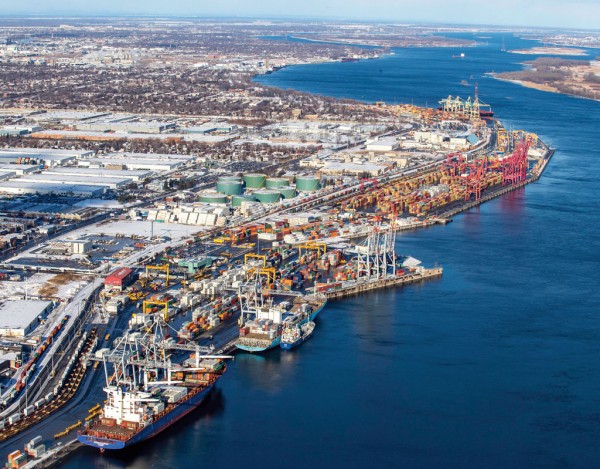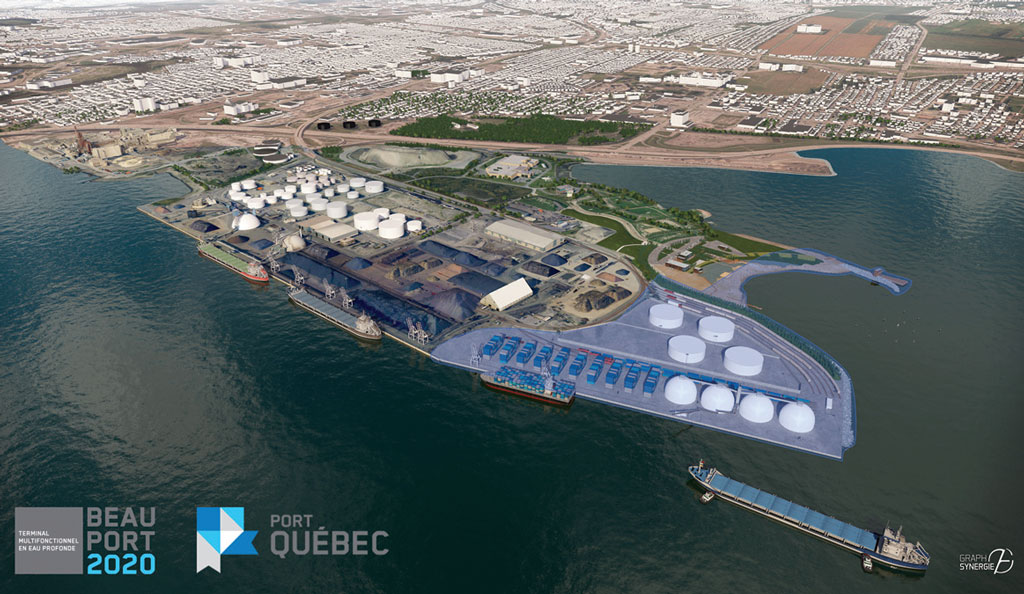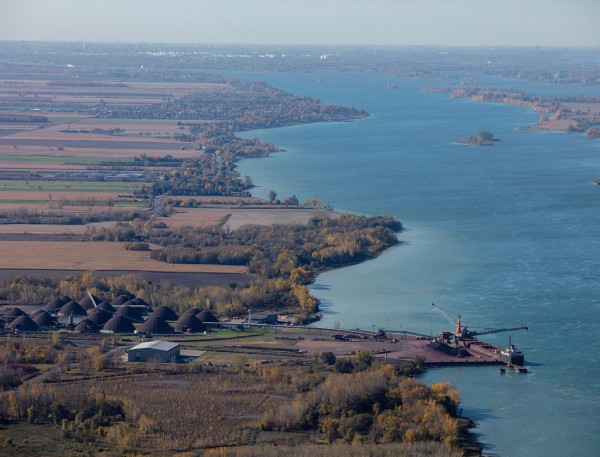Port of Quebec proposing a new St. Lawrence River containerport. The Port of Montreal is in the midst of expanding its container terminals. Is there room enough for two on the St. Lawrence?
Build it and the cargo will come. A familiar refrain that surfaces often by hopeful advocates of a major new project in the world marine industry. In the highly competitive container terminal sector, deep water, either natural or through dredging, can be a vital asset along with location in this fast-moving era of mega-ships. But other important factors can come into play when assessing whether certain projects are logistically or economically viable – certainly the case of the recent ambitious proposal of the Port of Quebec to enter the container game long dominated by the Port of Montreal on the St. Lawrence River.

A recent surprise announcement by the Port of Quebec to establish a container terminal stunned St. Lawrence River maritime circles (including the Port of Montreal). It also confounded Canadian consultants well versed in the special features and challenges of the continental waterway that allows ocean carriers to penetrate deeply into the industrial heartland of North America.
Quebec’s Surprise Plan
Last December, Mario Girard, president and CEO of the Quebec Port Authority, unveiled a plan to build a container terminal at the deep-water port aimed at boosting the competitiveness of the St. Lawrence gateway with U.S. East Coast ports accommodating much bigger ships (with capacities above 10,000 containers) since the 2016 enlargement of the Panama Canal.
He affirmed that the Port of Quebec, with its water depth of 15 meters [49.2 feet] at high tide (compared to Montreal at 11.3 meters [37-feet]), was strongly positioned to capitalize on the changing landscape of commercial shipping. “Quebec City,” Girard said, “must get on board and leverage its strategic location on the shortest route between Europe and the St. Lawrence-Great Lakes region, which is home to over 40% of the U.S. manufacturing industry.”

Worth recalling is the fact that there was no mention specifically of the Port of Quebec as a container player when the provincial government unveiled its ambitious Quebec Maritime Strategy in 2015. The over-arching goal was to develop Quebec Province as “the mega-hub of transatlantic trade.”
Much emphasis and government financing support subsequently flowed to the Montreal region as Quebec’s leading port, intermodal and industrial cluster arguably best placed to reap the benefits of such developments as the Canada-European Union free trade agreement in force since last September.
Costing an estimated C$400 million (US$309.74 million), the proposed terminal at the Port of Quebec, with nominal annual capacity of 500,000 containers, would be the revised principal feature of the Beaufort 2020 expansion project that was originally designed as a multi-purpose facility. The terminal would extend the port’s wharf line by 610 meters, connect with existing road and rail networks, and house a 17-hectare container yard.
“The Port of Quebec has many merits, but not for containers,” asserts consultant Brian Slack. “Logistics-wise, the container project does not make sense. A lot is going on globally revolving around the myth of mega ships of 20,000 TEU. It is far from reality, at least as far as North America is concerned.”
“What is striking about Montreal is its status as a destination port with the full discharge and load: you are typically bringing 4,000 containers in and you are taking 4,000 containers out. Now that is as good as you are going to get on any U.S. East Coast port where vessels make multiple stops.
“Try and find a port that can give you a turnaround of up to 8,000 TEUs. That’s pretty good going. Montreal is, in fact, a unique business model, with direct container services of small or what you could call medium-sized vessels.”
The Montreal Model
Other key features of the Montreal Model: the short dwell time of containers on docks (averaging 1.8 days) and two train days from Chicago. (However, as this edition was going to press, the Port of Montreal was working to reduce persistent truck congestion problems that began several weeks ago amidst the strong growth in container volume. Truckers have experienced wait times of three to four hours, prompting some haulers to charge shippers up to C$75 per waiting hour at terminal gates. While the port is investing in various fluidity projects (including connecting roads), extension of gate hours was being considered.)
In addition, Slack points to Montreal’s excellent intermodal connections with its core markets in Central Canada and the Midwest whereas Quebec has “an important rail connectivity issue. The Quebec box terminal at its location would need to be linked by shortline to the main CN line on the South Shore. If feasible, it could be very expensive.
“For Midwest traffic, there is rising competition from CSX and Norfolk Southern who are improving their services to the East Coast.”
Professor Claude Comtois, a transportation/logistics expert at the Université de Montréal, questions the viability of a 10,000-TEU container ship calling at the Port of Quebec. He points out that the Port of Quebec represents too much of a detour (more than a thousand nautical miles) to warrant mega-ship calls as well as at various ports on the U.S. eastern seaboard (as many transatlantic services via Halifax are structured). Thus, the Port of Quebec must constitute, in such cases, a destination port where all containers are loaded and unloaded (as happens in Montreal).
“But,” continued Comtois, “the small local market could generate barely 10% of this traffic – meaning thousands of containers will have to be transported by train or truck to markets well beyond the City of Quebec.”
As a result, apart from the increase in greenhouse gas emissions and road congestion around Quebec City, this implies, in his view, additional costs by truck and rail towards markets in Ontario and the U.S. Midwest compared with the services offered via the Port of Montreal.
“For a shipping line, there is no commercial justification for the creation of a container service in which the capacity of ship is dependent on distant markets already served in a competitive way by the Port of Montreal with well-established intermodal links,” Comtois said.
In a significant development, the Port of Montreal in early February moved an important step forward to establishing a sixth container facility to keep pace with projected demand and with massive infrastructure investments by U.S. East Coast ports by releasing an environmental impact report on the project at Contrecoeur. The latter is situated on the south shore of the St. Lawrence River, 40 kms (24.9 miles) downstream from Montreal. Assuming this project gains Ottawa’s green light (there are several wildlife habitat issues that do not appear insurmountable), the C$750 million (US$580.76 million) Contrecoeur facility would boost the port’s capacity from 2.1 million to 3.5 million containers upon completion slated for 2023.

Critical View of Maritime Employers
Meanwhile, the Port of Quebec must not only secure sufficient financing from government and industry sources, it must overcome serious reservations not just from a local environmental group known as Nature Quebec but from the influential Maritime Employers Association (MEA).
Headquartered in Montreal, the MEA represents vessel owners, operators and agents as well as stevedoring companies and terminal operators. Its members include such shipping lines as Maersk, MSC, OOCL, Fednav, CMA-CGM and Hapag-Lloyd.
Outlining its position in a recent statement, the MEA said it did not believe that the Quebec container terminal plan “answered a real need of industry and markets.” The MEA lauded Montreal’s vocation as a destination port. It singled out the extra surface transport costs implied from Quebec, and argued that, partly due to often difficult winter conditions, containerships larger than 8,000 TEU were not suitable for the St. Lawrence trades and the markets served by the Port of Montreal.
While the shipping lines themselves always ultimately decide where they load and unload cargo, industry observers see little evidence thus far that the Port of Quebec will emerge one day soon as a second container port on the St. Lawrence.





